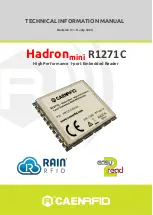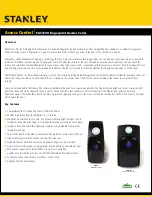
INSPECTION AND MAINTENANCE
Prior to initial use, all new, modified, and repaired hoists shall be inspected in accordance with Table 2. Thereafter, inspections
shall be conducted at intervals shown in Table 1; and items to be inspected are indicated in Table 2 by F (Frequent) or P
(Periodic).
Frequent Inspections
- Visual inspection by the oeprator or other authorized person. This inspection includes listening for
unusual sounds while the hoist is operated that may indicate deficiencies.
Periodic Inspections
- Audible-visual inspection as for Frequent Inspections, with some disassembly to allow a more detailed
inspection if external conditions indicate the need.
Exception
: Brakes require more than audible-visual inspection. Check daily by operating hoist with and without load, stopping at
various positions to test holding power and amount of drift, if any occurs. TO ADJUST BRAKE (Refer to Figure 1):
1. Fully tighten nut to position A.
2. Slack off nut from position A to position B and insert cotter key.
TABLE 1 - FREQUENCY OF INSPECTION
SERVICE
FREQUENT (F)
INSPECTION
PERIODIC (P)
INSPECTION
Normal
Monthly
Annually
Heavy
Weekly to Monthly
Semi-Annually
Severe
Daily to Weekly
Quarterly
TABLE 2 - INSPECTION CHART
In chart, F indicates Frequent Inspection, P indicates Periodic Inspection
LOCATION
CHECK FOR
F
P
LOCATION
CHECK FOR
F
P
Braking mechanism
Slipping under load
T
Hook Retaining
Members
(Pins, Bolts, Nuts)
Not tight or secure
T
Hard to release
T
Brake Parts
Hook Latch
Damaged; does not close
T
Brake Discs
Glazing
T
Suspension Members
(Sheaves,hand-wheels, chain
attachments, suspension bolts or
pins)
Excessive wear
T
Oil contamination
T
Cracks
T
T
Pawl; Ratchet
Excessive wear
T
Gears
Distortion
T
Pawl Spring
Corrosion; stretch
T
Broken or worn teeth
T
Hooks
Chemical damage
T
Cracks
T
Deformation
T
Inadequate lubrication
T
5% in excess of normal throat
opening
T
Load Block; Suspension
Housing
Distortion
T
T
10
E
twist from plane of unbent hook
T
Cracks
T
T
Cracks (dye penetrant, magnetic
particle, or other suitable detection
method)
T
Trolley; Supporting Structure
Possible inability to
continue supporting
imposed loads
T
Bolts, Nuts, Rivets
Not tight or secure
T
WARNING Label
Removed or illegible
T
Refer to ASME B30.16 for additional information on inspection, test, and maintenance.
3
Summary of Contents for L90
Page 7: ...6 ...



























